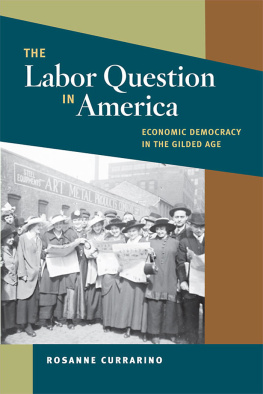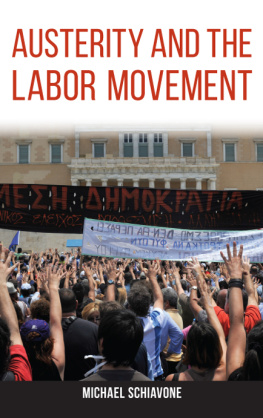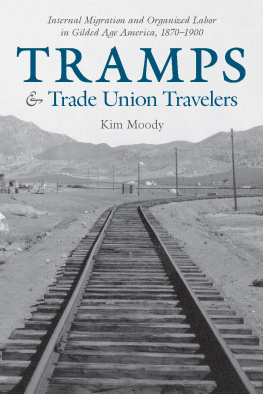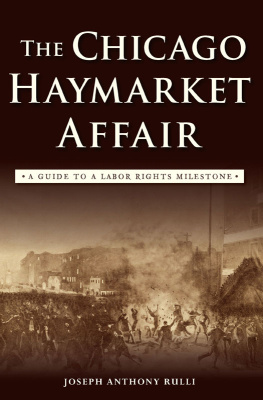James Green - Death in the Haymarket: A Story of Chicago, the First Labor Movement, and the Bombing That Divided Gilded Age America
Here you can read online James Green - Death in the Haymarket: A Story of Chicago, the First Labor Movement, and the Bombing That Divided Gilded Age America full text of the book (entire story) in english for free. Download pdf and epub, get meaning, cover and reviews about this ebook. year: 2006, publisher: Anchor Books, genre: Politics. Description of the work, (preface) as well as reviews are available. Best literature library LitArk.com created for fans of good reading and offers a wide selection of genres:
Romance novel
Science fiction
Adventure
Detective
Science
History
Home and family
Prose
Art
Politics
Computer
Non-fiction
Religion
Business
Children
Humor
Choose a favorite category and find really read worthwhile books. Enjoy immersion in the world of imagination, feel the emotions of the characters or learn something new for yourself, make an fascinating discovery.

- Book:Death in the Haymarket: A Story of Chicago, the First Labor Movement, and the Bombing That Divided Gilded Age America
- Author:
- Publisher:Anchor Books
- Genre:
- Year:2006
- Rating:4 / 5
- Favourites:Add to favourites
- Your mark:
- 80
- 1
- 2
- 3
- 4
- 5
Death in the Haymarket: A Story of Chicago, the First Labor Movement, and the Bombing That Divided Gilded Age America: summary, description and annotation
We offer to read an annotation, description, summary or preface (depends on what the author of the book "Death in the Haymarket: A Story of Chicago, the First Labor Movement, and the Bombing That Divided Gilded Age America" wrote himself). If you haven't found the necessary information about the book — write in the comments, we will try to find it.
James Green: author's other books
Who wrote Death in the Haymarket: A Story of Chicago, the First Labor Movement, and the Bombing That Divided Gilded Age America? Find out the surname, the name of the author of the book and a list of all author's works by series.
Death in the Haymarket: A Story of Chicago, the First Labor Movement, and the Bombing That Divided Gilded Age America — read online for free the complete book (whole text) full work
Below is the text of the book, divided by pages. System saving the place of the last page read, allows you to conveniently read the book "Death in the Haymarket: A Story of Chicago, the First Labor Movement, and the Bombing That Divided Gilded Age America" online for free, without having to search again every time where you left off. Put a bookmark, and you can go to the page where you finished reading at any time.
Font size:
Interval:
Bookmark:
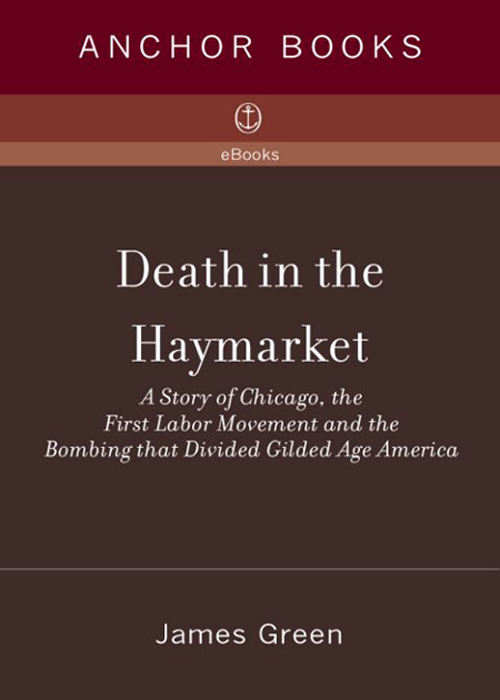
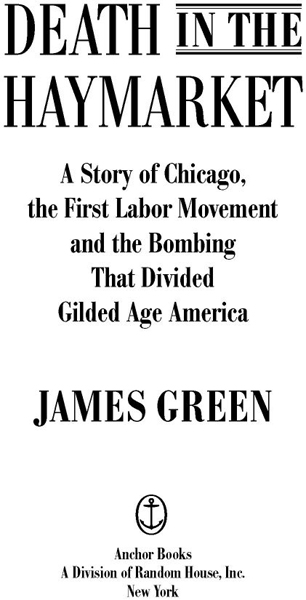
Table of Contents
To Janet and Nick
Acclaim for James Greens
Death in the Haymarket
No potboiler on the bestseller list can compete with Death in the Haymarket for narrative grip. Rich in character, profound in resonance, shot-through with violence, set in the immigrant neighborhoods, meeting halls, and saloons of the capitol of the American nineteenth century, here is a Chicago of life. Green renews that horror and shame for our time.
Jack Beatty, Senior Editor, The Atlantic Monthly
Filled with the suspense of a good novel, Death in the Haymarket vividly illuminates the shifting industrial terrain of late-nineteenth-century America. This is a work of art as well as history.
Alice Kessler-Harris, Bancroft Prizewinning author of In Pursuit of Equity
Green eloquently... produces what will surely be the definitive word on the Haymarket affair for this generation.
Publishers Weekly
James Green tells a powerful story of Chicago, America and the industrial world of the nineteenth century. His talents as a historian and a writer bring to life social and political struggles that helped make modern American society.
Steven Hahn, Pulitzer Prizewinning author of A Nation under Our Feet
A stunning portrait of America in the Gilded Age... and a bona fide page-turner to boot.
The Boston Phoenix
A compelling, even moving, version of the events surrounding Haymarket. He renders the executionor civic murder, as writer William Dean Howells bitterly called itof Albert Parsons, journalist August Spies, toy maker George Engel and printer Adolph Fischer in vivid detail.
Houston Chronicle
Greens re-creation of this terrible moment exposes the deep divisions that marred America at the dawn of the industrial age. As the nation again struggles with wrenching economic change, we need to hear the story that Death in the Haymarket so passionately tells.
Kevin Boyle, National Book Awardwinning author of Arc of Justice
Fast-paced.... Vivid.
The New Yorker
There have been poems about Haymarket... and novels... and chapters in books on the labor violence that is strangely omitted from our high school history textbooksbut nothing until now as meticulous as Greens account, nor as saddening.
Harpers Magazine
The Haymarket affair was a pivotal event in United States history. Green explains its significance with a scholars sure grasp of context and a storytellers skill at weaving a dramatic narrative.
Michael Kazin, author of A Godly Hero:The Life of William Jennings Bryan
The bombing and the infamous trial that followed are all vividly depicted in this crisply written, highly readable account. This is exceptional historical reporting and skillfully written with both color and clarity.
Tucson Citizen
A good, fast-paced read driven by fascinating characters.... Greens exploration of revolutionaries and their worldtheir newspapers, social clubs, festivals and fraternal organizationshumanizes men and women who, in their lifetimes, were constantly dehumanized by an astonishingly biased press. This book enriches our understanding of a road not taken.
The New York Sun
Maps
Chicago in the early 1880s, showing prominent railroads, industries and other important sites 103
Locations of major strikes in Chicago during the Great Upheaval from April 25 to May 4, 1886 175
Chicagos Haymarket Square area on the night of May 4, 1886 187
Prologue
AS THE SUN ROSE over Lake Michigan on May 5 in 1886, Chicagoans beheld one of the brightest mornings in memory. In the early light of day, merchants, managers and brokers boarded horse-drawn streetcars on the South Side and headed north on Michigan Avenue toward the business district. Along the way they encountered a few high-hatted rich men, like the great manufacturer George Mortimer Pullman, being driven uptown in fancy carriages from their mansions on Prairie Avenue. Marring the commuters eastward view of Lake Michigans azure blue reaches, black freight trains rolled along the shoreline laden with baled cotton from the Mississippi River delta, cut lumber from the piney woods of Texas and soft coal from the mines of southern Illinoisall crucial ingredients in the citys explosive industrial growth during the 1880s. Indeed, the businessmen who went to work in Chicagos financial district that spring day in 1886 were in the midst of a golden decade of profit, when the net value of goods produced by the citys leading industries multiplied twenty-seven times, ten times faster than the average yearly wage.1
But that first Wednesday in May when commuters gazed west over the widest industrial landscape in the world, they saw something unusual: a clear sky above the prairie horizon. Gone was the cloud of thick smoke that always hung over the city. The only signals of industrial activity came from the tall chimneys of the huge McCormick Reaper Works two miles away, where strikebreakers, guarded by Chicago police, kept the factory in operation. Scores of other plants and shops remained shut down on this fifth day of a mammoth general strike for the eight-hour day that had begun on May 1.
As the black-coated businessmen entered the downtown area, they could see knots of pickets around the soot-blackened warehouses that stretched along State Street all the way up to the Dearborn Station. Striking freight handlers had stanched the flow of interstate commerce through Chicagos immense grid of iron rails. In solidarity, switchmen had refused to switch trains in one central railyard, crippling the mighty Chicago, Burlington & Quincy Railroad, the citys largest freight handler. 2 Trains still chugged into the city that day, but when the locomotives reached the depots, they sat idle, stuck on the tracks with unloaded cargoes.
Looking back into the rising sun, the businessmen would have seen hundreds of boats riding at anchor in the outer harbor. The captains of side-wheel steamers had banked their boilers, and sailors on lake schooners had struck their sails under orders from the alarmed vessel owners. A vast quantity of wheat and cut lumber awaited shipment, and there were lucrative tons of iron ore and anthracite coal to be unloaded, but the spring shipping season had been ruined by the storm of strikes that had swept over the city. Vessel owners feared for the safety of their ships if they ventured down the South Branch of the Chicago River to unload in the industrial zone because angry strikers, many of them Bohemian lumber shovers, had taken over the lumberyards and could, at any moment, put a torch to their wooden boats and the acres of dry lumber nearby.3
The strike wave even reached outside the city, to the enormous railroad car shops in the model town George Pullman had built to escape the turmoil of Chicago. Seemingly unconcerned with labor unrest in the city and in the town he owned, Pullman arrived for work as usual at his palatial company headquarters on Michigan Avenue. Stepping out of a carriage driven by a well-dressed black man who wore his own high hat, the world-renowned industrialist and city builder entered his office building looking as he did every morning, walking purposefully and wearing his usual outfita Prince Albert coat, striped trousers and patent-leather shoes.4
Yet, beneath his businesslike demeanor, George Pullman suffered from feelings of uncertainty. My anxiety is very great, he wrote to his wife, although it is said that I appear very cool and unconcerned about it. The stunning breadth of the eight-hour strike shocked him. He had constructed his company town nine miles from industrial Chicago, where poverty and despair had poisoned relations between manufacturers and their hands and caused frequent strikes, lockouts and riots. In Pullmans model community, carefully selected workmen earned high wages, rented comfortable new houses and lived a healthy life in a clean place. Now the toxic fumes of class antagonism were wafting through the streets of his planned community. Some change must occur very soon now, he told his wife, but I cannot yet predict what it will be. 5
Next pageFont size:
Interval:
Bookmark:
Similar books «Death in the Haymarket: A Story of Chicago, the First Labor Movement, and the Bombing That Divided Gilded Age America»
Look at similar books to Death in the Haymarket: A Story of Chicago, the First Labor Movement, and the Bombing That Divided Gilded Age America. We have selected literature similar in name and meaning in the hope of providing readers with more options to find new, interesting, not yet read works.
Discussion, reviews of the book Death in the Haymarket: A Story of Chicago, the First Labor Movement, and the Bombing That Divided Gilded Age America and just readers' own opinions. Leave your comments, write what you think about the work, its meaning or the main characters. Specify what exactly you liked and what you didn't like, and why you think so.


